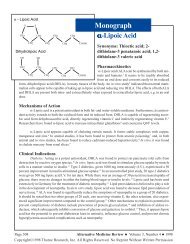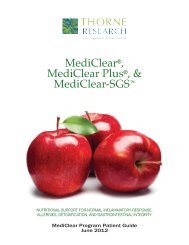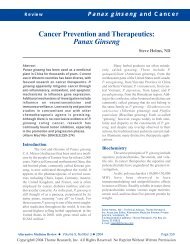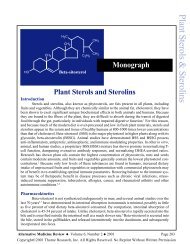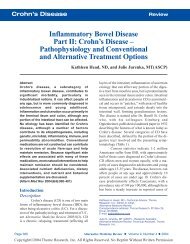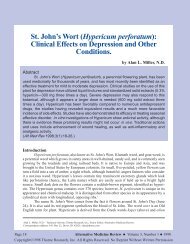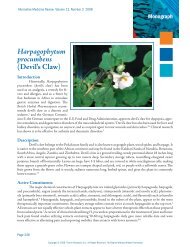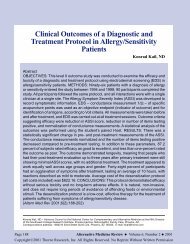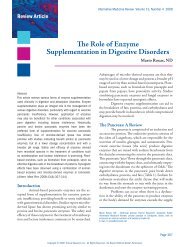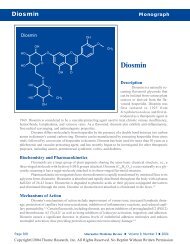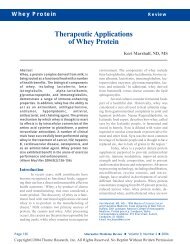Inulin-Type Prebiotics â A Review: Part 1 - Alternative Medicine ...
Inulin-Type Prebiotics â A Review: Part 1 - Alternative Medicine ...
Inulin-Type Prebiotics â A Review: Part 1 - Alternative Medicine ...
Create successful ePaper yourself
Turn your PDF publications into a flip-book with our unique Google optimized e-Paper software.
<strong>Review</strong> Article<br />
<strong>Alternative</strong> <strong>Medicine</strong> <strong>Review</strong> Volume 13, Number 4 2008<br />
source rich in fructans. Production of FOS begins with<br />
a more fundamental molecule (typically sucrose). Commercially<br />
available inulin-type prebiotics differ in purity,<br />
fructan and free-sugar content, and fructan portfolios.<br />
By applying specific production technologies to either a<br />
food source of fructans (such as chicory root) or sucrose,<br />
the food industry can produce a diversity of inulin-type<br />
prebiotic products with different DP and sugar portfolios<br />
with slightly different strengths and weaknesses.<br />
Production of Oligofructose, <strong>Inulin</strong>, and<br />
<strong>Inulin</strong> HP<br />
The starting plant material for production of<br />
oligofructose, inulin, and inulin HP is in most cases<br />
chicory root (Figure 3), preferred because it contains<br />
high amounts of inulin-type fructans. The inulin is<br />
extracted by hot water. The result of this extraction<br />
is ~92-percent inulin-type fructans of both GF n<br />
and<br />
F n<br />
types with DP ranging from 2-60 and a DPav of<br />
~10-12. About 10 percent of the fructans in this minimally<br />
processed inulin might have a DP ranging from<br />
2-4 and 20 percent might range from 5-9. This extract<br />
will also contain a small amount (6-10%) of free sugars<br />
(the monosaccharides fructose and glucose and the disaccharide<br />
sucrose), present in the starting root material<br />
and not a result of hot water extraction. 7,9<br />
<strong>Inulin</strong> can be further processed into more<br />
purified inulin-type prebiotic products (oligofructose<br />
or inulin HP). Total enzymatic hydrolysis results in<br />
monosaccharide molecules of fructose and glucose.<br />
<strong>Part</strong>ial enzymatic hydrolysis can produce oligofructose<br />
mixtures with a DP ranging from a hot-water extracted<br />
inulin to a pure mix of completely enzymatically hydrolyzed<br />
monosaccharides. An endoinulase is used for partial<br />
enzymatic hydrolysis of inulin. 7,9,24<br />
Depending on the DPmax, DPav, DP range,<br />
and the amount of free sugars desired, the degree of<br />
partial hydrolysis can produce oligofructose products<br />
with different portfolios of fructans and free sugars. To<br />
appropriately compare products, the DPmax, DPav, DP<br />
range, and free-sugar content must be known.<br />
Whether or not inulin undergoes partial enzymatic<br />
hydrolysis to produce oligofructose, physical<br />
separation techniques can be applied to produce products<br />
of higher purity and more uniformity. Using partial<br />
hydrolysis and/or physical separation techniques,<br />
products with 99-percent purity can be produced. 7,9<br />
Figure 3. Cichorium intybus (Chicory)<br />
Because of additional processing, commercially<br />
available products with the generic names inulin<br />
or oligofructose are not identical in purity. Standard<br />
inulin (92% fructans and 8-10% free sugars) and lowsugar<br />
versions of inulin (99.5% fructans and ~0.5%<br />
sugars) are both referred to as inulin. Oligofructose<br />
syrups with ~60-percent fructans and ~40-percent<br />
sugars are commercially available as are syrups with<br />
~95-percent fructans and ~5-percent sugars. Oligofructose<br />
syrups and powders with other specifications<br />
are also commercially available. 9<br />
Production of FOS<br />
FOS is produced by an entirely different<br />
method. Using the fungal enzyme beta-fructosidase,<br />
derived from Aspergillus niger, FOS is enzymatically<br />
synthesized using a process called transfructosylation.<br />
The starting molecule used is sucrose, and the enzyme<br />
activity sequentially adds fructose units with new beta<br />
(2−1) linkages placed in the chain. Unlike inulin and<br />
oligofructose, which have all glycosidic bonds between<br />
fructose units in the beta (2−1) configuration, transfructosylation<br />
does not result exclusively in beta (2−1)<br />
fructosyl-fructose glycosidic bonds; other linkages occur<br />
in limited numbers. 7-9,24<br />
Enzymatic synthesis from glucose produces<br />
short-chain, low-molecular weight inulin-type fructans<br />
with a DP range of 2-4. 8,9,24<br />
Page 320<br />
Copyright © 2008 Thorne Research, Inc. All Rights Reserved. No Reprint Without Written Permission.



